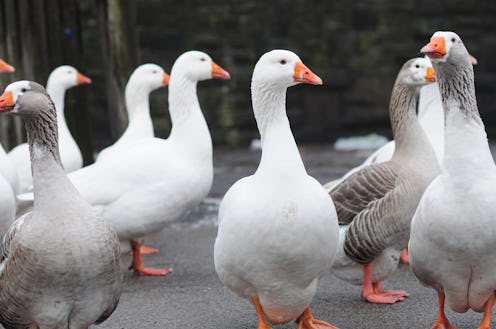
Halloween season may be over, but we're still juuuuust about to get into the coldest months of the year — and you know what that means: Goosebumps. But why do we get goosebumps, anyway? Do they serve any sort of purpose? That's what NPR's Skunk Bear You Tube channel tackles in its latest video, and as it turns out, the answer is yes. We do get goosebumps for a reason, and it goes all the way back to our ancestors. Who knew, right?
Fun fact: The word “horror” has its roots in the Latin verb “horrere,” which means “to bristle” (just like the hairs on your arm do when you get goosebumps). As such, it shouldn't be much of a surprise that the technical term for goosebumps is a word that shares the same root: “Horripilation,” which Merriam-Webster defines as, “a bristling of the hair of the head or body (as from disease, terror, or chilliness); goose bumps.”
So where does the whole “goose” thing come into play? The actual medical term for goosebumps is “cutis anserina,” with “cutis” meaning “skin” and “anserina” meaning “goose.” Have you ever looked at the skin of a plucked bird (whether it's an actual goose, a chicken, or something else)? When we horripilate, our skin looks kind of like that — hence the term, “goosebumps.” (No, not that kind of Goosebumps .)
Here's How It Works:
When you're scared or cold, glands on top of your kidneys release adrenaline. You might best know adrenaline from the rush you get when you do something thrilling, which can be pretty fun — but it's actually a stress hormone that helps prep your body for its fight-or-flight response. It widens your airways and raises your heart rate, ensuring that your muscles will have all the oxygen they need to either flee or stand your ground.
And…
...It causes tiny muscles under your skin to contract. This is what causes the bumps on the surface of your skin to rise, bringing the little hairs on your arms, the back of your neck, and so on up with them.
So What Good Are They?
Do goosebumps seem kind of useless to you? They're not — particularly if you're an animal other than a human. Horripilation raises the quills on a porcupine, for example, amping up its best defense mechanism.
Goosebumps also cause fur and hair to puff up, trapping in heat and keeping mammals warm when it's really effing cold out. Humans don't have much body hair these days compared to our ancestors, but once upon a time, the insulating properties of goosebumps were immensely valuable.
But What About…
...Goosebumps occurring when we do things like listen to music? Why would a beautiful piece of music kick in our fight-or-flight response? That actually goes back to adrenaline: According to Scientific American, adrenaline is released not only when we feel cold or afraid, but also when we “feel strong emotions, such as anger or excitement.” It might be caused by something different, but the effect on our bodies is the same — and voila: Goosebumps.
Watch the full video below for more:
Images: sk8geek/Flickr; Skunk Bear: Science from NPR/YouTube (4); Giphy